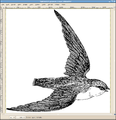Commons:Pearson Scott Foresman
Pearson Scott Foresman is an educational publisher that sent 16 boxes of illustrations (which are diverse in wide ranges of topics) to the Wikimedia Foundation office in Spring of 2007, donating them into the public domain in the process, for use on Wikimedia Commons.
See Commons:Pearson_Scott_Foresman/Complete_List for complete list
Here are the sample images (divided into its distinct categories that are touched up by the contributors and are ready to be used in Wiki projects.
The Project[edit]
By November of 2007, only a fraction of the images had been scanned and even fewer uploaded (see Category:PD-ScottForesman and Category:Pearson Scott Foresman publisher). This is primarily due to the limited availability of volunteers in the Wikimedia offices. Going forward, in order to ease the process (and to avoid having to ship 16 boxes to San Francisco), we are uploading only the raw scans of images, in order to open up the project to volunteers worldwide.
How to participate[edit]
The raw scan[edit]

To the left is a sample scan. Unprocessed scans may be found in Category:ScottForesman-raw. Each item should be extracted from this image.
Image editing[edit]
Typical work, using your favorite graphics editing program would be as follows:
-
Cropping: Selecting around the object and cropping the image
-
Rotating: This image had to be rotated 180 degrees
-
Grayscaling: As the image is line art, grayscaling it reduces the size of the image and removes discoloration due to age
-
Whitepoint: Changing the whitepoint removes the darkness from the background. This can also be done with varying success with "Contrast" or "Levels"
Whitepointing in GIMP[edit]
A simple guide to apply a sort of whitepointing in GIMP
Note: It is highly encouraged to save as .png instead of .jpg/.jpeg
-
The cropped, grayscaled, possibly rotated source image
-
Adjust the color levels, place the white mark at the right of the visible spectrum, place the black mark at the left of the minor spectra on the other side. The image corresponds to a case of a picture with an spectrum with two distinct areas, which requires more trial and error to get the desired results.
-
Erase any residue in the white area (remember to remove alpha channel)
-
Apply a Gaussian Blur - 5/5 is a good value
-
Readjust the color levels again, 15% on each side might do the trick
-
Apply an unsharp mask, use a radius of 30 and an amount of 1.
-
The final result!
Uploading[edit]
This image is then saved as a grayscale PNG (which is a preferred format for black and white line art) file and uploaded as Image:Toad (PSF).png. The "PSF" (Pearson Scott Foresman) is tagged on to the image name to avoid conflict with other images that may have been uploaded to Commons.
Uploads should use the template {{ScottForesman}} for permissions and source.
If using the new upload wizard, follow the steps in uploading
(1) Release rights - Select "This file is not my own work".
(2) Another reason not mentioned above - Select and key-in {{ScottForesman}}
- Add the following parameters to the processed images:
{{ScottForesman}}
(3) Add the necessary info such as dates P.S: If you do not choose to categorize the image yourself, please add the {{Uncategorized}} template, in order that others who are following image cleanup do it.
After uploading , edit the following in the processed images:
{{ScottForesman|raw= #File:Original Scanned Images.png}}
- Add the following parameters to the raw images :
{{ScottForesman-raw
|date=2007-12-3 22:54 (UTC)
|images= <gallery>
Image: #ImageExample1.png
Image: #ImageExample2.png
Image: #ImageExample3.png
Image: #ImageExample4.png
</gallery>
}}
The above images were extracted as follows:

Step 1 - Images on the right are one of the examples of raw scans of the COM:PSF. Unprocessed scans may be found in Category:ScottForesman-raw. Each item should be extracted from this image.

Step 2 - Use GIMP (or your any of the alternate software), in this case I demonstrate using GIMP for processing images

Step 3 - On the menu tab , click on Images -> Mode -> Grayscale to remove any of the residue colours on the images for the easier processing of the images on the next step

Step 3 - On the menu tab , click on Colors -> Curves to adjust the curves to easily remove any of the residue colours that should not belong to the pics (Example greyish tone)

Step 4 - Adjust the curve (to look like it is more like S-Shaped curve) to remove the residual grayish tone. In very severe cases, try J-shaped curve to remove the severe grayish tone and the S-shaped curve

Step 5 - Final product should looked like this
Uploading[edit]
Use the upload and when uploading , select "This file is not my own work" and filled necessary infos.
On the tab "Now tell us why you are sure you have the right to publish this work:" , choose " Another reason not mentioned above" and type '''{{PSF}}''' which is the license template for Pearson Scott Foresman License custom Common License for uploads.
IMPORTANT: To all potential project contributors: All of the images uploaded should end with (PSF) Note: Based on the instructions on the now deleted categories: https://commons.wikimedia.org/w/index.php?title=Category:ScottForesman-raw
Completing[edit]
Finally, update the image description page of the original scan. Most, if not all, of the original scans will be tagged with the {{ScottForesman-raw}} template (if not, they should be). Place the images in a <gallery> using the images parameter; see this diff link for an example. Doing this will categorize the raw image under Category:ScottForesman-raw-processed.
Image usage[edit]
Don't forget to look for places where to use these images! You can see some examples of where they are being used in Commons:Pearson Scott Foresman/Usage.
For more statistics of the , you can look the statistic here.
.png/80px-Setback_-_Architecture_(PSF).png)
.png/115px-Cubism_(PSF).png)
.png/120px-Heart_Diagram_(PSF).png)
.png/97px-Woodpigeon_(as_%27Ring_Necked_Dove%27_in_PSF).png)
.png/120px-Golden_Retriever_-_Dog_(PSF).png)
.png/59px-Sari_(PSF).png)
.png/120px-Sanskrit_(PSF).png)
.png/120px-Nile_River_(PSF).png)
.png/77px-Zither_(PSF).png)
.png/120px-Pegasus_(PSF).png)
.png/120px-Sagebrush_Steppe_(PSF).png)
.png/120px-Radioactive_decay_of_atomic_nucleus_(PSF).png)
.png/120px-Ship-Of-The-Line_(PSF).png)
.png/120px-Hurdle_Race_(PSF).png)
.png/111px-Satellite_Cylinder_(PSF).png)



.png/115px-Toad_(PSF).png)







.png/120px-Toad_2_(PSF).png)
.png/120px-Toboggan_(PSF).png)